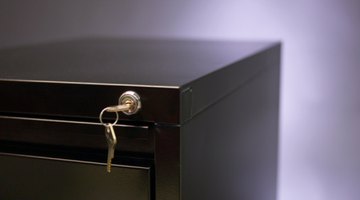How to Drill Out a File Cabinet Lock
Filing cabinets typically contain a variety of papers and documents necessary in a professional or private capacity, or they carry sentimental value for the owner of the cabinet. Most filing cabinets come outfitted with a lock to protect the confidentiality of such papers.

When the key to the lock cannot be found, panic and a hasty search are not necessary. Whether an inadvertent key loss occurred or a used locked filing cabinet was purchased with no available key, drill out the lock and release it with the proper tools and basic power tool know-how.
Things You Will Need
- Steel drill bit set
- Drill
- Machine oil
- Flat-head screwdriver
Tip
Destroying the tumbler system in a file cabinet lock is usually successful on the first effort due to its relative simplicity. Sewing machine oil and other general purpose household oils work well for lubricating drill bits.
Warning
Keep the drill steady to avoid breaking the drill bit off inside the lock. Steel drill bits are hard, yet brittle, and must remain aligned in the direction in which they start.
-
Insert an appropriately sized steel drill bit into the chuck of an electric drill and tighten securely with a chuck key. Choose a drill bit that fits the longest part of the keyhole entry point. This permits the bit to focus on the destruction of the lock tumblers.
-
Apply a small amount of machine oil to the drill bit to reduce heat caused by friction generated by drilling the metal lock assembly.
-
Begin drilling at a medium speed applying a firm, steady pressure on the drill. When the drill completely penetrates the lock mechanism, set the drill into its reverse mode and slowly extract it from the file cabinet lock.
-
Insert a flat-head screwdriver into the slot of the lock mechanism and turn clockwise. If the file cabinet lock is completely destroyed internally, the release lever will trip, allowing access to the cabinet drawers.
-
Repeat Steps 1 through 4, graduating to the next largest drill size if needed.
The Drip Cap
- Filing cabinets typically contain a variety of papers and documents necessary in a professional or private capacity, or they carry sentimental value for the owner of the cabinet.
- Most filing cabinets come outfitted with a lock to protect the confidentiality of such papers.
- When the drill completely penetrates the lock mechanism, set the drill into its reverse mode and slowly extract it from the file cabinet lock.
Writer Bio
Max Stout began writing in 2000 and started focusing primarily on non-fiction articles in 2008. Now retired, Stout writes technical articles with a focus on home improvement and maintenance. Previously, he has worked in the vocational trades such as automotive, home construction, residential plumbing and electric, and industrial wire and cable. Max also earned a degree of biblical metaphysician from Trinity Seminars Ministry Academy.
Photo Credits
- Hemera Technologies/AbleStock.com/Getty Images
- Hemera Technologies/AbleStock.com/Getty Images
More Articles



